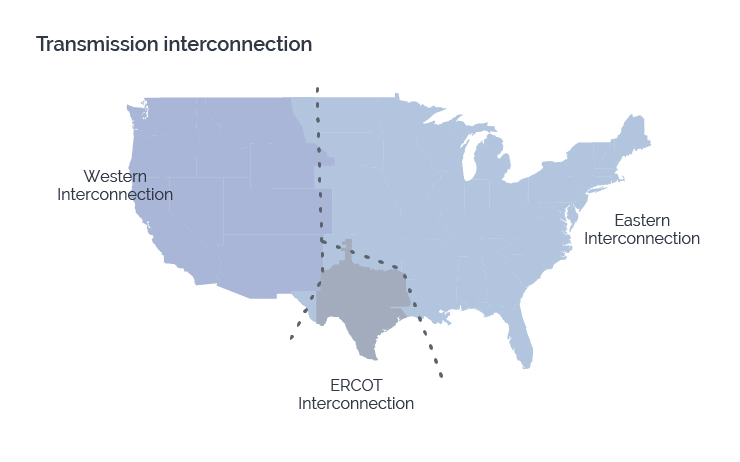ERCOT & Rotating Outages
Electric Reliability Council of Texas (ERCOT)
The Electric Reliability Council of Texas (ERCOT) manages the flow of electric power to more than 26 million Texas customers — representing about 90 percent of the state’s electric load.

ERCOT has four primary responsibilities:
- Maintain system reliability.
- Facilitate a competitive wholesale market.
- Facilitate a competitive retail market.
- Ensure open access to transmission
Seasonal Conservation Tips for ERCOT Conservation Appeals and Warning
Conservation is a reliability tool ERCOT has deployed more than four dozen times since 2008 to successfully manage grid operations and maintain system reliability.
This notification is issued when projected reserves may fall below 2500 MW for 30 minutes or more.
To do your part in helping to prevent any rotating outages and keep the lights on in your home and those around you, follow these simple tips to conserve energy year-round:
Summer:
- Set your thermostat to 78 degrees or higher—every degree of cooling increases your energy use by six to eight percent.
- Turn off lights and pool pumps and avoid using large appliances like ovens, washing machines and dryers.
- If you don’t need something—turn it off and unplug it if possible.
Winter:
- Set your thermostat to 68 degrees or under.
- Avoiding using major appliances such as dryers during peak morning and evening hours.
- Close shades and blinds to reduce heat leaving your home.
- Bundle up and utilize clothing and blankets for additional warmth.
- Turn off unused lights and unplug any nonessential equipment and appliances as they can still draw current, even when turned off.
ERCOT’s use of Energy Emergency Alerts
Electric Reliability Council of Texas (ERCOT) has a progressive series of emergency procedures that may be used when operating reserves drop below specified levels. These procedures are designed to protect the reliability of the electric system as a whole and prevent an uncontrolled system-wide outage.
Per ERCOT Protocols and North American Electric Reliability Corporation (NERC) requirements, the grid operator is required to declare an Energy Emergency Alert (EEA) when operating reserves drop below 2,500 MW or system frequency cannot be maintained above certain levels and durations. There are three levels of EEA, depending on the amount of operating reserves that are available to meet the electric demand on the system.
When ERCOT issues an EEA, it is able to take advantage of additional resources that are only available during scarcity conditions. Resources include demand response that is procured specifically for these types of conditions (Emergency Response Service and other demand response from Transmission Operators); use of resources that are normally set aside to provide operating reserves (including mandatory load reduction from some industrial facilities); additional generation or imports from neighboring regions; and voluntary conservation by consumers.
If all of the EEA tools listed above are insufficient, rotating outages are required to help preserve the reliability of the system as a whole. However, rotating outages have only been implemented four times in the history of ERCOT.
Energy Emergency Alert Levels
EEA Level 1
When operating reserves drop below 2,500 MW and are not expected to recover within 30 minutes, grid operators can call on all available power supplies, including power from other grids, if available.
EEA Level 2
EEA 2 will occur if reserves reach 2,000 MW and are not expected to recover within 30 minutes, or if frequency has dropped below 59.91 Hz for 15 minutes.
When operating reserves are less than 2,000 MW and are not expected to recover within 30 minutes, ERCOT can reduce demand on the system by interrupting power from large industrial customers who have contractually agreed to have their electricity turned off during an emergency. ERCOT can also use demand response resources that have been procured to address tight operating conditions.
EEA Level 3
An EEA Level 3 is declared if operating reserves cannot be maintained above 1,500 MW, and are not expected to recover within 30 minutes, or if frequency drops below 59.8 Hz for any period of time. If either of these events occur, ERCOT will order transmission companies to implement controlled outages, which impact residential, commercial, and industrial users
FAQ
What is a rotating outage?
Rotating outages are controlled, temporary interruptions of electrical service implemented by utilities to reduce demand and preserve the reliability of the electric system as a whole. Utilities are required to shed load based on their percentage of historic peak demand. Rotating outages are only used as a last resort to bring operating reserves back up to a safe level and maintain system frequency.
Rotating outages primarily affects residential neighborhoods and small businesses. Each transmission company is responsible for determining how they will shed their portion of the load on the system.
ERCOT has initiated system-wide rotating outages four times in the history of ERCOT (Dec. 22, 1989, April 17, 2006, Feb. 2, 2011 and February 15-18, 2021).
What is a statewide power emergency?
ERCOT issues a Power Emergency, or Energy Emergency Alert Level 3, when there is not enough electric generation available to keep up with consumer demand. When an EEA Level 3 is issued, ERCOT instructs utilities to begin rotating outages according to predetermined emergency curtailment procedures. When ERCOT issues such an order, the Lower Colorado River Authority (LCRA) follows ERCOT’s instructions to reduce power consumption by instituting rolling outages within its service territory.
Why is my power off?
How long will my power be off?
My power was off earlier today or yesterday in a rolling outage. Am I safe for the next one or could it go off again?
Why was my house or business chosen to be part of the outage?
The power outage has caused a life-or-death emergency in my home or business. What do I do?
How often has ERCOT initiated system-wide rotating outages?
ERCOT has instituted system-wide rotating outages four times in the history of ERCOT (Dec. 22, 1989, April 17, 2006, Feb. 2, 2011 and Feb. 15-18, 2021.)
How can I help conserve power?
You can help by turning off all unnecessary lights and electrical appliances and delaying laundry and other activities that consume electricity. Read other conservation tips from the Public Utility Commission of Texas.
How can I monitor the level of Energy Emergency Alerts?
Download the ERCOT mobile app from the Apple App Store or Google Play (or visit ERCOT.com.) Follow ERCOT on social media channels such as Facebook and Twitter.

